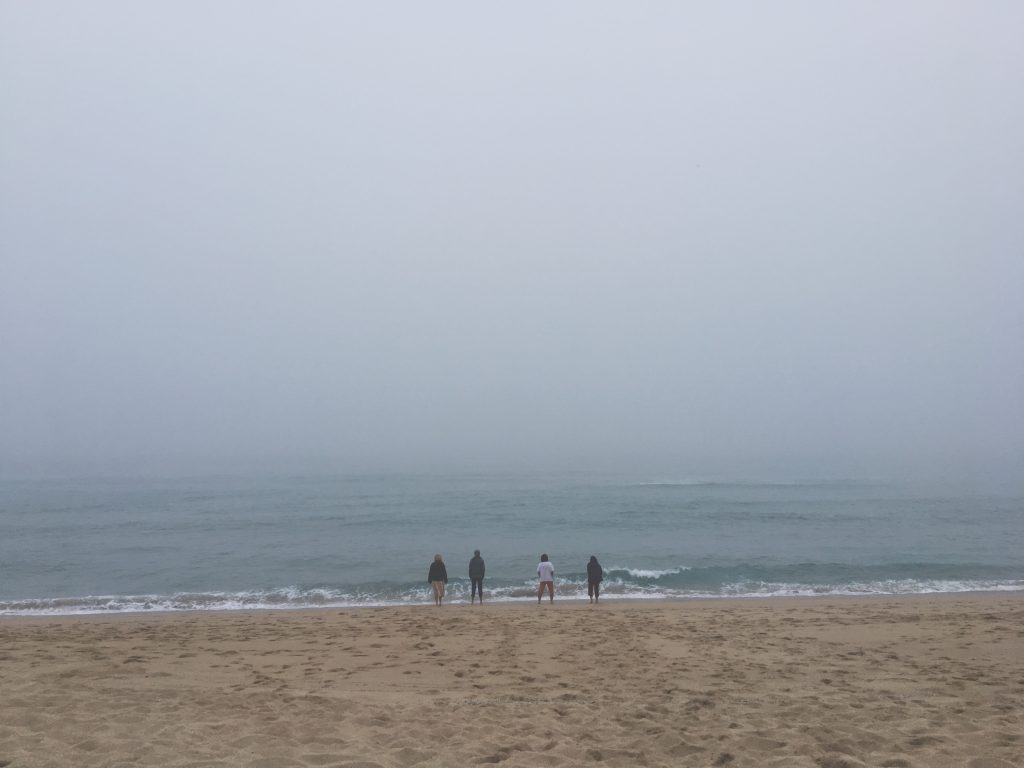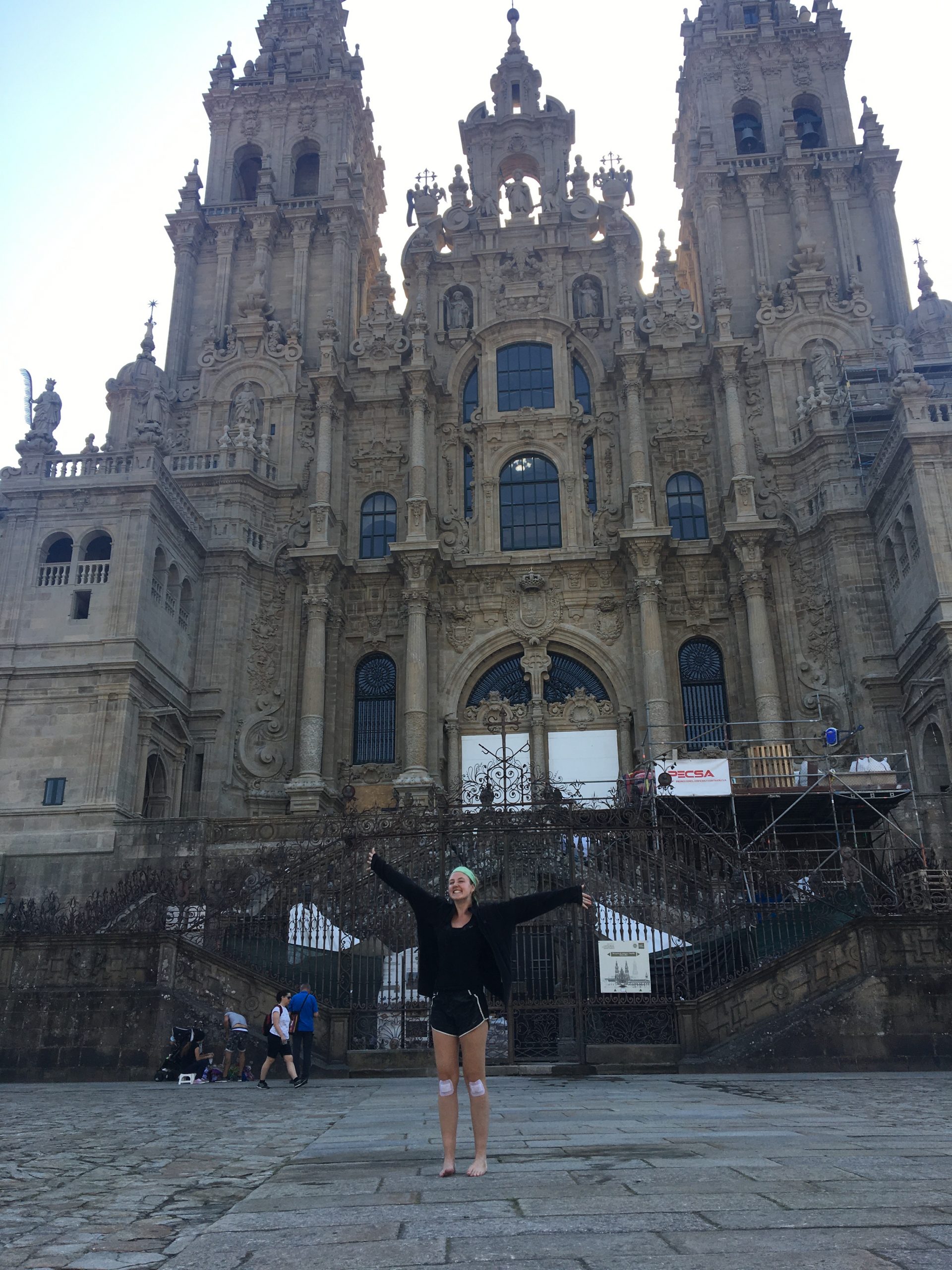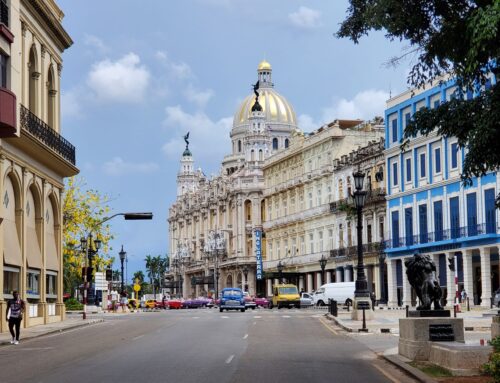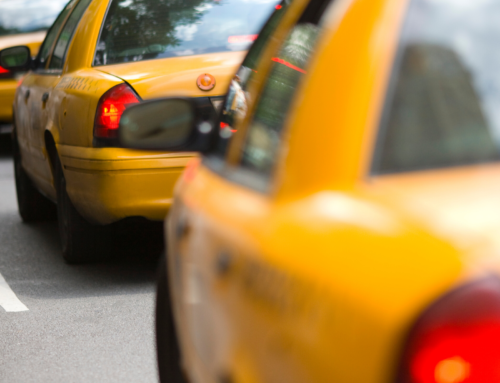The Millennial Pilgrim: The Influence of Technology and the Questions of Authenticity and Spirituality on the Camino
Introduction: The Camino in the 21st Century
From sunrise until sunset every day for weeks, people carry backpacks and hiking poles across mountains and plains to reach the sacred city of Santiago. While this may sound difficult, tiring, and even dangerous for some, the Camino is a healing, dreamlike pilgrimage that has served people from the time of the supposed discovery of St. James’s remains in 812 AD to contemporary times. Today, there is a significant and growing interest in pilgrimages, and none other is more popular than the Camino de Santiago. In 2016, nearly 300,000 pilgrims of 153 different nationalities participated on the journey, with approximately 180,000 of those traveling the French Way, making the pilgrim route more popular and diverse than ever before (CaminoWays). However, especially since the rise of smart technology, authenticity is often debated in modern day pilgrimages, contesting not only why pilgrims choose to make their journey, but also how they act on the journey.
Technology has certainly influenced the Camino in the last decade. Internet forums display information on how pilgrims should plan and pack for the journey, apps help guide pilgrims on where to stay each night, and social media and blog posts proliferate and are undoubtedly cause for much of the route’s popularity. It seems that technology has found its place on the Camino, but some scholars disagree. Nancy Frey, author of Pilgrim Stories: On and Off the Road to Santiago argues that the use of technology inhibits an authentic pilgrimage experience (Frey). However, unlike participants between the typical ages of 30 and 60, participants from a younger generation have grown up in a world where they are always “connected”, and consciously leaving that world of constantly sharing at home can prove difficult.
Pilgrims under thirty are among the least noticed of the possible pilgrim categories on the Camino, but with technology influencing their lives from adolescence, these pilgrims are a lens into the evolution of religious pilgrimages in the 21st century. While pilgrims choose to go on the Camino for many reasons, religious is in the minority of pilgrims’ motivations (Oficina de Acogida al Peregrino). Yet, the Camino continues to grow in popularity, despite its religious history. The term “pilgrim”, which has been used to define people who journey over a long distance to a sacred site as an act of religious devotion, deserves reclaiming. In her talk “The Smart Camino: Pilgrims in the Internet Age”, Nancy Frey notes that infrastructure of the Camino is undergoing changes (Frey). While it is natural for a route that has been in existence for over a thousand years to experience change, the presence of technology causes uneasiness among pilgrims who believe that technology has fundamentally changed the Camino. A contemporary representation of a historically religious pilgrimage is necessary for understanding how youths blur the line between secular and sacred, and therefore how youths live spiritually today.
Examining pilgrims under thirty, and their spirituality and interaction with social media, should offer a more contemporary and human example of how millennials have reclaimed a historically religious experience to address their modern needs.
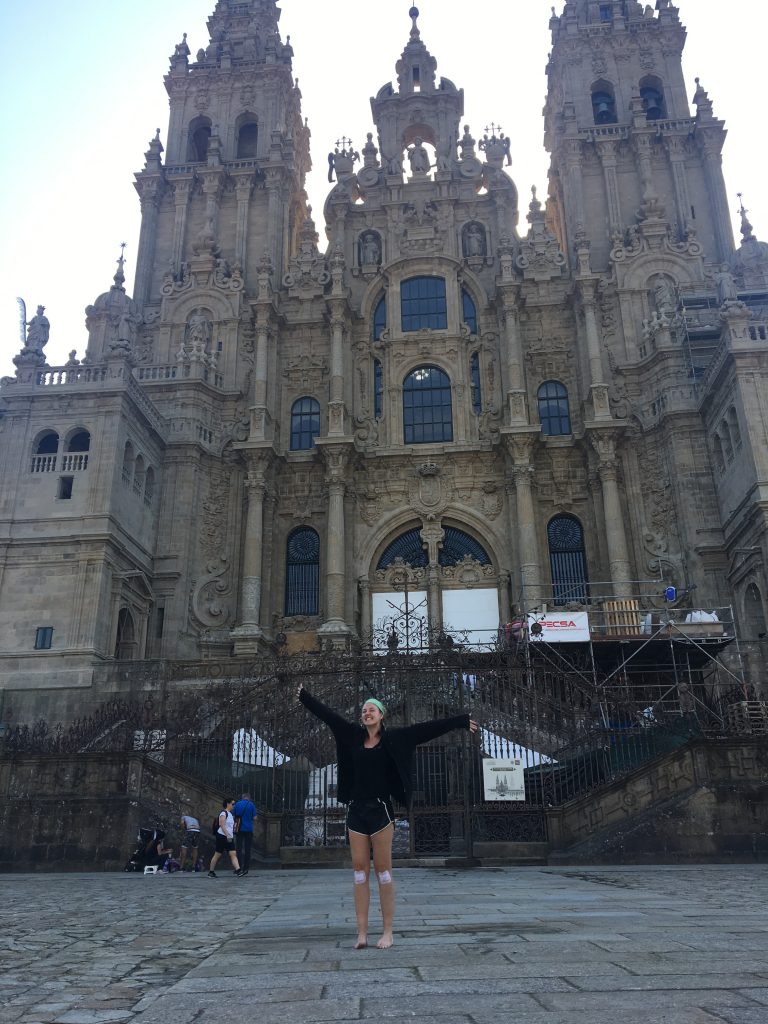
Estella Brenneman ´20 in front of Santiago de Compostela Cathedral
What I Found
Over the course of my two and a half weeks on the Camino, I interviewed fifteen people. For my two-week period of walking, I was satisfied with the level of participation I had. Twelve of my participants were in my targeted age range, between 20 and 30 years old. Three of my participants were between 40 and 60 years old, which is a more common age range to see walking the Camino. I interviewed eight women and seven men. Eight of my participants were from the United States, one was from Canada, two were from Germany, one was from the Netherlands, one was from Denmark, one was from Italy, and one was from Israel. Each travelled alone. Given my small sample size, and inability to speak other languages aside from English and French, I am satisfied with the diversity in my participants.
Of the fifteen people I interviewed, only one expressed doing the Camino for religious purposes. The answers I received from others were mixed, but all of them had a general sense of needing to leave their world behind and do something different, in search of a spirit of adventure. When I asked my participants, if they told me that they were not religious, whether they were spiritual people, thirteen of my fourteen remaining participants described themselves as spiritual people. When I asked if they would not mind describing their definition of spiritual, their answers were hesitant and confused at first, which I had expected. When asked before if they were religious people, they usually say, “No, but I am spiritual”, as an alternative to religious. But they themselves struggle with coming up with a definition for the word they use. Participants tended to arrive at a similar definition, however, which described an intense, deep connection to themselves, other people, and nature. None of these answers included any implicit or explicit reference to technology. Per my questionnaire, I followed up this notion of spirituality with asking whether the Camino has enhanced their spirituality, and received affirmative answers each time. In Sarria, I began to notice a change from the spirituality that many pilgrims had been describing to me.
Although I had only been walking for just over a week before I reached Sarria, I witnessed an abrupt shift in the tone of the Camino. In Sarria, the worst of the criticisms of the Camino are confirmed. Sarria, with 13,700 residents, is the most densely populated city on the French Way towards Santiago, and is a popular starting point for many pilgrims on the Camino. While most towns leading up to this point are small, old, and quiet, Sarria resembles urban life more than the peace and quiet that is familiar to many of the pilgrims. Upon entering Sarria, I saw many more tourist shops, murals, yellow arrows, tour buses, and all things Camino. “Long distance pilgrims” would express their nervousness for the last 100 kilometers, as it meant walking alongside the “short distance pilgrims”. To earn a compostela the minimum distance that a pilgrim must walk, established by the Church, is 100-kilometers. This meant that many more Spanish people, or people who only had time to start their Camino in Sarria, begin walking. During the day, the route suddenly and dramatically becomes more crowded, with larger groups of people and school groups occupying a lot of the physical walking space. The tone feels different among these people too. While the Camino up until this point has been a solitary but shared experience between individuals, the route becomes overwhelmed by large and often noisy groups of people. Although pilgrims I spoke with tried earnestly to not become annoyed by their new company, I still noticed a distinct tension between long distance pilgrims and short distance pilgrims. In fact, the two groups would not interact on the Camino. I, too, had no interaction with any short term pilgrims. It’s hard to know how to even approach them. Short distance pilgrims were recognizable because they typically had small backpacks (with no shell), shoes that would not be suitable for long distance walks, daytime (not workout) clothing, no walking poles or staff. Furthermore, these pilgrims were seen using their phones more frequently, and school groups would often walk by playing loud music out loud, not with headphones in. These pilgrims also walked at a pace that was much faster than long distance pilgrims, usually to get a bed at an albergue. This rush to albergues was typical of the walk after Sarria, as the sudden overcrowding causes pilgrims to worry that there would not be enough beds.
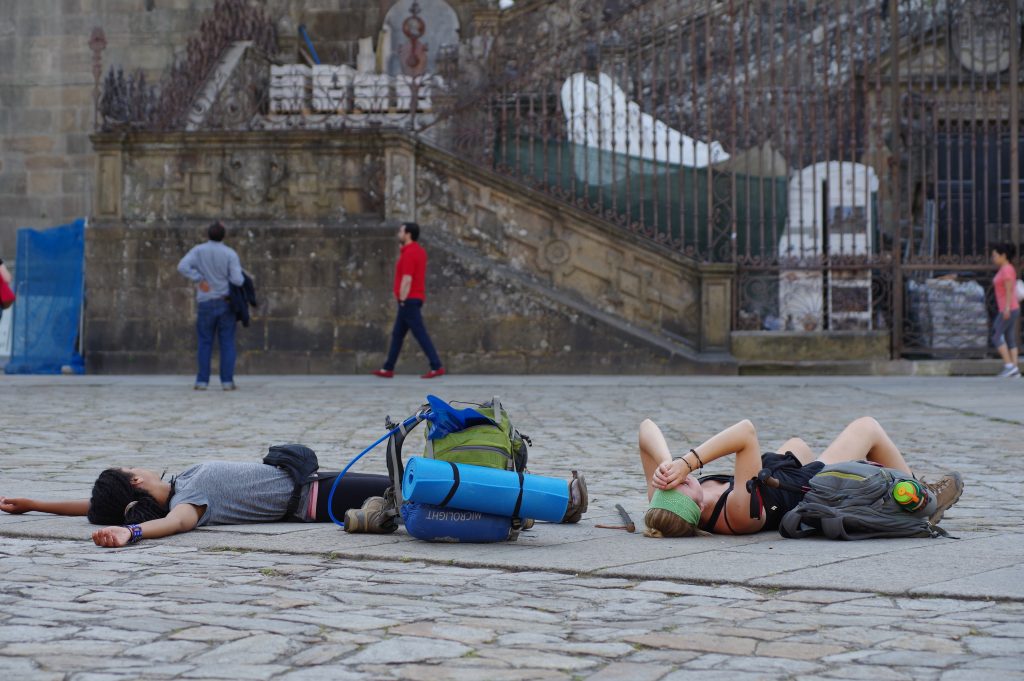
I encountered mixed relationships and criticisms of technology when I was on the Camino. Each of my 15 participants carried at least one mobile device with them, with one carrying two. Of the fifteen people I interviewed, only one was frequently found using their phone throughout the day. Otherwise, I rarely found people using their phones during the walking period of the day. Even when people walked alone, it was rare to see a pilgrim walking with headphones in or with their eyes on their phone. Pilgrims I spoke with would often have their phone turned off during the day, or on silent, so that they would be less inclined to look at incoming notifications. The albergues usually have curfews at 10 pm, when all pilgrims must be in bed with the lights off. Adjusting to this is difficult for many young pilgrims, as they are used to staying up until later hours before they fall asleep. At this point, you can look around the room and see several dimly lit screens illuminating people’s faces before they fall asleep. Regardless, however, pilgrims are conscious of leaving technology behind, or at least adjusting their relationship with technology while on the Camino.
As for social media posts, I looked at people’s Facebook, Instagram, and Snapchat accounts. I would also see people using WhatsApp frequently, which is a messaging app. Most used WhatsApp to communicate with people on the Camino so that they could meet up in a town, but some used it to communicate with friends or family from home. I noticed that most people who used the app to communicate with people from home would record the voice and send voice messages, rather than sending texts. I did not ask whether this was something people did while they were at home as well, or whether this pattern was exclusive to the Camino. On Facebook, several of my participants made Facebook posts before their departure, explaining the journey of the Camino and expressing excitement. Some participants made posts on Facebook during the Camino, usually of something found in nature, a group of friends, or a church or other novelty sight on the Camino, usually with friend’s names and locations tagged. And then at the end, some of my participants made Facebook posts with a burst of as little as 5 to as many as 30 photos of the Camino, sharing that they had finished and expressing gratitude. Typically, people made frequent Facebook posts or a singular Facebook post and regular Instagram posts. Posts on Facebook that were made at the beginning or the end of the Camino were typically longer posts, with more words in the caption describing the pilgrimage experience, whereas frequent posts on Facebook had shorter, nondescript captions. Pilgrims who posted on Instagram would post with relative frequency, between every five days and every week and a half. Posts could include several photos or only one, and usually had a short, nondescript caption, with friend’s names and locations tagged. A few participants would post Instagram stories with more frequency, which, like a Snapchat story, disappears from your account after 24 hours. Others, when asked about their social media accounts would tell me, very seriously, that they have not posted anything on social media since being on the Camino, as if that were an achievement itself. Seven of the participants in my targeted age range did not post to social media at all during the Camino. At the end of the Camino, four of those six made Facebook posts with a burst of photos from the journey. Two of the six made a Facebook post prior to their departure.
When I asked why people posted on social media or refrained from posting on social media, I received interesting answers from both perspectives. Participants who were in between the ages of 40 and 60 usually had families of their own, and therefore articulated a need to update their families, so that they knew they were safe. One participant also expressed to me that he enjoyed posting regular updates to Facebook because he knew of people his age who were inspired to go on the Camino because of his posts. Participants in the 20 to 30 age range were accustomed to posting on Instagram when they were home. One participant reflected to me that she believed her posts on Instagram impacted her relationships in a positive way; when she takes photos of her friends and posts them, she enjoys seeing them look at the photos and feel special because the shared memories had a place on her social media account. Another participant who posted frequently on Instagram said that posting to her social media was a way to assert herself and her identity as being “worth it” and to attract interest in her journey. People who chose to not post to social media commented on its addictive quality, and also noted how a one-lined caption did not do enough justice to how the Camino has impacted them.
I asked several participants who I knew posted on social media throughout the Camino whether their relationship with social media or their phone has changed since they returned home. One participant said that “for the most part, [they] feel happy that [they] could share pieces of the Camino with loved ones… It was to show [their] identity was worth something, but more so what [they are] choosing to do with life in this time.”

Motivations of Medieval and Modern Pilgrims
Since the earliest human peregrinations, people have wondered how to travel more fruitfully, more fulfillingly, more soulfully, but it would be unfair to assume that medieval pilgrims were necessarily more authentic than contemporary pilgrims. During medieval times, being a pilgrim on the Camino de Santiago meant walking the way with an expressed religious purpose. At the end of the Middle Ages, the Camino fell out of favor for almost 500 years, but in the last twenty years it has staged a stunning comeback. Sarah Blitzer of the University of Pennsylvania conducted research on the Camino from the perspective of historical preservation, and provides a lens into the motivations of medieval pilgrims. While pilgrims first arrived in Santiago de Compostela “haphazardly, individually”, more responded to the miracles associated with the saint and then “progressive routinization and institutionalize of the sacred journey” developed. These journeys further contributed to the saint’s miracle collection as any pilgrimage will “accrete rich superstructures of legend, myth, folklore, and literature.” Further miracles attributed to the saint occur as pilgrims make the difficult journey, further strengthening the routes power to draw more pilgrims (Blitzer). The pilgrimage perpetuates itself – through the miracle collection, guides, and word of mouth – as more pilgrims travel the route. As the political climate changes, as the popularity of a given saint’s cult rises and declines and then rises again, so too do pilgrimages. The surrounding political and social climate, as well as the influence of plenary indulgences for walking during a Holy Year, influenced pilgrims then, as it does with pilgrims today. Today, modern pilgrims hear and tell stories of the Camino de Santiago as if it has a healing power, similar to the power of miracles. As one participant told me, we live in an era of storytelling. But medieval pilgrims were attracted by storytelling as well, as they were drawn by stories they read in the Bible and the accumulation of miracle stories on the Camino. Now, it is likely that we will hear about the Camino through social media, through friends or family who have taken the journey, through movies and books, such as the popular 2010 movie “The Way” starring Martin Sheen.
In addition to forgiveness and devotion, pilgrimage was the only means of escape from medieval society, and in many ways, modern pilgrims feel the same way. It was the only journey that an individual could take away from their homes and villages. While the decision to undertake a pilgrimage was an individual one, the experience brings the pilgrim “into fellowship with like-minded souls, both on the way and at the shrine” (Blitzer). Pilgrims, then and now, are brought to the Camino by stories, in the hopes that they too will have their spirituality enriched and deepened, in ways that are not possible in the society from which they come.
